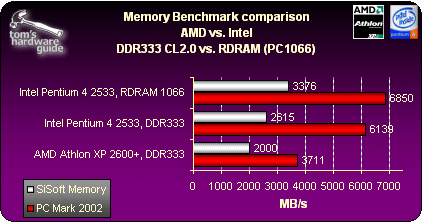At The Last Second: AMD's Trump Card - The Athlon XP 2600+
Heat Dissipation And Clock Increase
Compared to the Thoroughbred "A," the attainable clock increase of the Thoroughbred "B" is immense because the internal heat dissipation can be decreased. The top model of the Thoroughbred "A" CPUs (the Athlon XP 2200+ with 1800 MHz) has a maximum heat dissipation of 67.9 Watt, which is just behind its predecessor, the Athlon XP 2100+ (1733 MHz) with the Palomino core, at 72 Watt.
The Thoroughbred "B" has a heat dissipation of 68.3 Watt at 2133 MHz - which, if you consider the higher clock speed, is a smaller increase. Future versions of the Athlon XP with 2400 MHz (XP 3000+) will have a heat dissipation of about 77 Watt.
Correction In Model Numbering: Now At 133 MHz Increments
With the launch of the Athlon XP with the Palomino core, AMD also introduced its new model number system, called P-rating. The idea behind this was to create a direct comparison to arch-rival Intel, which markets its CPUs using "real" megahertz figures. This is a language that the less tech-savvy customers can understand: megahertz and gigabyte. As we've already determined in numerous articles, a processor's performance capabilities cannot be analyzed in terms of pure clock rate numbers.
In any case, our recent test comparisons made it clear that the model numbering for the top AMD CPUs did not correspond to the performance of comparable P4s. Because of this, AMD adjusted its virtual values to become lower: previously, a clock increase of 66 MHz meant the equivalent of 100 additional points; now, the 100 points are related to the absolute values. This is AMD's admission that the previous performance scale was set too high, especially when it came to the higher clock speeds .
The Chipset Bottleneck: Memory Interface Puts The Brakes On Athlon
A thorough analysis of the memory-dependent benchmarks clearly reveals that, when used with the top AMD and Intel models (Athlon XP 2600+ and Pentium 4/2533) under the same conditions (DDR333 with CL2.0), the P4 can show a significant advantage in applications.
Here, the Intel 845G and the VIA KT333 platforms act as the basis. In extreme cases, the difference in memory access speed can be up to 30%. However, in this regard, AMD is not the guilty one, since the chipsets come from other manufacturers. VIA continues to have problems designing a high-performance memory interface - a fact that is supported by our benchmarks.
Get Tom's Hardware's best news and in-depth reviews, straight to your inbox.
Current page: Heat Dissipation And Clock Increase
Prev Page And Now, More Speed: Copper Interconnects At Nine Levels Next Page The Same Ol' Topic: Protection Against An AMD Thermal Death